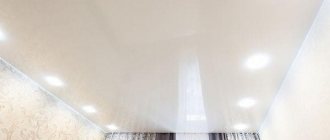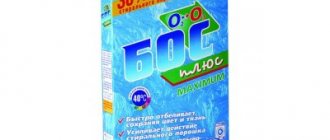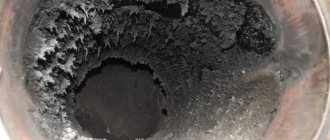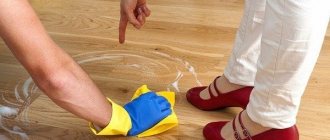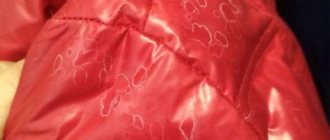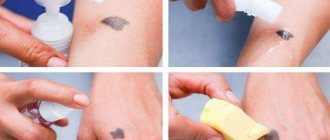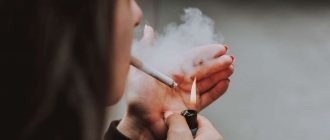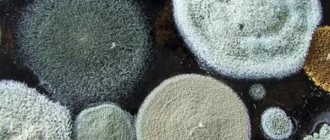Article current as of: January 2022
Stretch ceilings have long gained popularity due to their smooth, even and shiny surface, which makes the interior of the room elegant and aesthetic. In addition, if necessary, it levels the ceiling, hides structural defects and hides wiring.
Modern tension products are made from PVC film or polymer fabric. Such materials require proper care, otherwise the surface may deteriorate, lose its presentable appearance, or even become deformed. In this article we will look at how to care for a stretch ceiling without harming the product.
General rules for caring for suspended ceilings
Stretch ceilings in living rooms can be washed no more than once a year. Ceilings in the kitchen and bathroom require more careful maintenance. In the first case, fat gradually accumulates on the surface and a thin layer of soot forms, even despite the good operation of the hood. In addition, an unpleasant yellow coating, yellow spots and oil splashes appear on the kitchen ceiling.
In the bathroom, traces of drops and splashes of water remain on the ceilings, which are especially visible on dark glossy fabric. Ceilings in the kitchen and bathroom should be washed at least once every six months. At the same time, it is recommended to immediately remove fresh stains on any surface that have appeared, for example, from splashes of food or champagne. In this case, dirt can be easily removed with a regular dry cloth.
Before washing or cleaning the ceiling, it is important to choose the right detergents. Use only gentle compounds or specialized solutions for caring for suspended ceilings, soft sponges and napkins, and rags. To prevent the ceiling surface from being accidentally scratched, be sure to remove bracelets and rings from your hands during the procedure. It is better to wash products with gloves.
For washing, do not use abrasive detergents, solvents or aggressive compounds. It is not recommended to care for stretch ceilings using a mop or broom. They can scratch the surface or press on the material, and the broom will also leave clouds of dust in the air. It’s better to take a stepladder and carefully wash the product with your hands using a cloth.
You need to wash the suspended ceiling carefully and carefully using soft and smooth movements from left to right and back and forth. Ceiling seams are washed lengthwise. Do not use circular motions to avoid leaving soapy streaks. Do not rub the surface too hard or press hard on the material, otherwise you may scratch the product or leave a dent.
What types of spots are there and why do they appear?
Having noticed contamination, the first thing you should do is understand why it appeared . This is necessary in order to know how to remove stains from a stretch ceiling and prevent their occurrence in the future.
We carefully examine the stain. So:
1. Yellow spots. They can occur for two reasons:
- High humidity , which leads to rust on the ceiling. The leak must be repaired as quickly as possible. Water may appear from neighbors above or due to faulty ceiling pipes. Residents of the private sector and the top floors of apartment buildings have yellow ceilings due to leaking roofs.
- Tobacco smoke. Does anyone in your household smoke in the apartment? You may not be surprised that stains have appeared on the stretch ceiling. It is much better to smoke outside than to wash the material for a long time and thoroughly.
2. White spots. Most often, such stains occur in the bathroom due to the chemical composition of water, which, evaporating, is absorbed into the coating.
3. Grease stains and soot. These stains sooner or later appear in the cooking area.
4. Stains from drinks, paint or cosmetics. An unsuccessfully opened bottle of champagne, an exploding jar of compote, wild games of children, painting walls or metal pipes - there are many everyday situations in which you can stain the ceiling.
Three ways to clean a suspended ceiling
- Dry cleaning with a cloth or napkin with soft short pile is the safest and most reliable way to clean PVC film. Take microfiber, flannel or wool cloths. To care for fabric stretch ceilings, take a brush with soft, long bristles;
- Dry cleaning with a vacuum cleaner. It effectively removes accumulated dust and debris and removes cobwebs. But this procedure must be carried out extremely carefully so as not to accidentally tear off or peel off the film. Therefore, choose the minimum operating mode or use a special washing attachment;
- Washing with water and detergents should be done once a year. To wash a matte or glossy stretch ceiling, use a special polish or aerosol, soap solution or dishwashing detergent. Such products will easily remove traces of glue and paint, tobacco smoke, dirt and grease. And to add gloss and shine, wipe the surface with ammonia or regular vodka.
Removing dirt from PVC ceilings
This process is simple. Stains are removed using a soft material such as a sponge and a soap solution at a temperature slightly above room temperature. Grease from the ceiling surface is removed with a dishwashing detergent.
If dried pieces of food are stuck to the ceiling canvas (and this happens), then you should not try to tear them off or pick them out. Just wet the surface with soapy water and give it time to soak, after which they will be wiped off easily and without problems. Stains from cosmetics are scrubbed off using ammonia. After the fight against dirt is completed, wipe the surface of the stretch ceiling with a dry cloth, sponge or napkin. There are many more photos and videos on the Internet that will clearly demonstrate how to remove dirt.
How to wash a suspended ceiling without streaks
To clean glossy or matte PVC ceilings, first remove cobwebs and dust with a dry soft cloth. In residential areas, wipe the surface with a soft cloth soaked in clean water at a temperature of up to 40 degrees. Do not make circular movements to avoid leaving streaks! For dirty ceilings and ceilings in the kitchen and bathroom, take ceiling or dish detergent or prepare a soap solution.
To prepare a soap solution, grate a bar of solid soap on a coarse grater and mix with water until foam forms. Or mix water with liquid soap. Wipe the ceilings with your chosen product. To do this, move from left to right from one corner to another or in sections. After treatment, wipe the surface with a clean damp cloth and wipe dry.
Finally, the material can be wiped with a solution of ammonia or regular vodka. For the solution, mix ammonia and water in a ratio of 1 to 9 (10% ammonia). First wipe the film with the solution and then polish with a dry cloth. This will bring back the shine and shine to the ceiling.
How to clean a fabric stretch ceiling
Fabric ceilings are something between a glossy and matte surface. Moreover, maintaining satin stretch ceilings is easier. They do not require wet cleaning or polishing. In addition, you can clean the surface using a vacuum cleaner and water steam, a steam generator or a steam mop.
To remove difficult stains, use classic products for washing suspended ceilings or dishes. Also, 10% ammonia solution effectively removes contaminants. Dampen a soft sponge with the mixture and gently wipe the stained area.
A steam generator or steam mop does an excellent job of removing greasy and burnt stains, scale, and traces of oil and food. In addition, water steam is used to clean various surfaces, including ceilings and walls, furniture and equipment. It is suitable for almost all materials except MDF panels. By the way, this cleaning method is effective for ceramic tiles and the seams between them. It removes dirt, debris, mold and mildew.
Water vapor is not recommended for cleaning and processing PVC film. Otherwise, under the influence of hot steam, it may peel off. However, it is ideal for fabric ceilings. How to quickly and effectively remove fat in the kitchen, read the link https://vsepodomu.ru/uborka/kak-ochistit-zhir-na-kukhne/.
How to clean a suspended ceiling after a leak
When there is a leak, a flood, or a pipe breaks in a suspended ceiling, water accumulates inside and it hangs down like a bubble. After this unpleasant event, you just need to carefully drain the water. After draining, there will be no problems when caring for stretch glossy and matte ceilings. They do not require special cleaning or repair. After dismantling, the ceiling will look like new.
The greatest difficulty is caused by the fabric ceiling, since it does not retain moisture. After a leak, rust remains on the surface, which penetrates deep into the material and spreads throughout the entire thickness of the canvas.
In this case, simple cleaning methods do not help. But don’t rush to replace the entire canvas. You can easily paint over a spot or paint the entire ceiling surface using acrylic paint. By the way, fabric ceilings can be painted up to five times.
The main reasons for the appearance of yellow spots on the ceiling
There are practically two reasons for the appearance of yellow spots on the ceiling. The most common sources of this negative phenomenon are excess moisture or poor quality material used in repairs, as well as violations of technology during repairs. The most obvious sign of “excessive” moisture is flooding (neighbors above have flooded, the roof of the house is leaking, heating pipes or water supply pipes have burst when they are installed at the top, etc.). However, the source of yellow spots can also be the lack of sufficient ventilation in the apartment. In such a situation, water vapor in the form of condensation will settle on the ceiling, which can lead not only to the formation of stains, but also cause the appearance of various types of fungal colonies, including the most dangerous variety for human health - black mold.
If the ceiling remains damp for a long time, this can lead to corrosion of the reinforcement in the concrete floor slabs and the appearance of rust stains on the ceiling, which are very difficult to remove, since this requires destroying the concrete, getting to the reinforcement and carrying out anti-corrosion treatment on it, then is to eliminate the source of rust. And this is a rather labor-intensive and costly process.
In some cases, the reason for the appearance of yellow spots on the ceiling may be poor-quality materials used in renovating the apartment, or a violation of the technology during the renovation (the oil paint coating was not completely removed, the ceiling was not primed and treated with antiseptics, etc.). In this case, it will be necessary to eliminate the mistakes and miscalculations made during the repair. However, before deciding how to remove yellow stains on the ceiling, you must first determine the reasons for their appearance, since cosmetic camouflage can hide them for a very short time and over time the stains will appear again in all their “glory.”
Methods for cleaning coatings at home
Using an eraser
You are lucky if your ceiling is matte, because in this case, a regular eraser left over from school can handle particularly stubborn stains. Just don’t overdo it, otherwise you’ll rub a hole where the dirt was.
Water + alcohol
If you don’t have a special polish, just use a soft solution of warm water and a small amount of alcohol/vodka (based on 1 tablespoon of preparation per 1 liter of liquid). This is an excellent tool for eliminating stains after wet washing of the stretch fabric, which also saves from dust. And remember that abrasive, kerosene-containing and acetone-containing preparations are completely prohibited.
Ammonia hydrate
A solution with this substance is recommended for cleaning delicate surfaces from greasy food stains. It does not spoil the coating, carefully removing dirt and leaving long-awaited cleanliness.
Dish detergent
It is quite possible to save a suspended ceiling from a layer of soot after cooking: just foam 1 teaspoon. l. kitchen cleaning product in a small container with heated water (maximum permissible temperature is 35 degrees, higher is prohibited). It is important to achieve a thick, fluffy foam, because it is this that will be used, and not a concentrated solution.
Be sure to remove jewelry from your hands before the procedure so as not to damage the delicate fabric. Then take a fiber/flannel cloth or sponge, use it to apply a little of the product to the ceiling and wipe it without pressing hard. Rinse off any remaining residue with clean water using a different cloth. Absorb moisture with soft paper napkins.
Soap solution
This is the most inexpensive and simple option, which has three interpretations:
- adding liquid soap without dye to the water;
- dissolving toilet soap;
- rubbing laundry soap into shavings and beating the liquid until foamy.
The water should be warm in all cases. The concentration of the drug depends on your needs: when there are no deeply ingrained stains, you need a regular, weak solution. You can buy high-quality purified water of the highest category on the website https://voda-slavnitsa.ru/.
Washing powder
You should choose a powder or stain remover for clothes that does not contain bleaching ingredients. It needs to be dissolved in such a way that there are no small grains left that could scratch the ceiling. If you are sure that you have not missed a single granule, you can treat difficult-to-remove problematic stains with this product. Of course, this method is too harsh for simply wiping off settled dust - use it as a last resort.
Wiper
The ammonia included in the preparation is of particular value for the stretch fabric here. That is, it makes sense to choose only those household chemicals that have ammonia mentioned on the label. Just spray it on and go over the surface with a dry, soft cloth, as you would normally wash a window glass or mirror. This method is great for removing stains from glossy PVC film because the surface is shiny and streak-free. But with all the convenience of the technique, do not rush to immediately try it on the entire ceiling: first, it is better to treat an inconspicuous piece to make sure that a particular product is safe.
Ammonia
You will not need the alcohol itself, but a 10% solution of it. Using this substance, it is worth wiping tarnished canvases so that they acquire a renewed look. Just a few light movements, and the stretch ceiling will shine again.
How to remove stubborn stains
It happens that when painting a hood or pipes, a few drops of paint fall on the ceiling. Traces must be removed quickly before they dry out. If the drops are old, they are moistened with water and washed off after 10-15 minutes. In difficult cases, you can apply a little white spirit to the contaminated area using a cotton swab, being careful not to go into the clean area, and then rinse immediately.
The grease is wiped off with a soft sponge or microfiber moistened with dishwashing detergent. Then wipe the surface with clean water and dry with a soft cloth. If the stain cannot be removed immediately, leave the composition on for 2-3 minutes.
There are also more persistent marks, but they can also be dealt with.
Marker and other inks
When marking the ceiling, for example, for lamps, use markers. Sometimes they accidentally leave marks on a visible area.
It is recommended to wipe off dirt caused by a water-based marker with a dry piece of cloth or a piece of cloth soaked in a soapy solution. If the felt-tip pen is alcohol-based, use pure vodka or a soap solution with added alcohol.
More aggressive compounds such as white spirit and gasoline galoshes are used with great caution. The cleaner is applied to a cotton pad and rubbed back and forth, without going beyond the stain. If traces of the marker cannot be removed, they are masked with white corrector. This option is more suitable for matte and satin fabrics.
Ketchup
Traces of ketchup need to be removed as soon as possible. Tomatoes contain coloring substances that can leave yellow spots even here. Tomato sauce is scrubbed with dishwashing detergent. The liquid is applied to the stain and allowed to dissolve for several minutes. Then they follow the standard procedure.
It is more difficult to remove such stains, especially old ones, from fabric coverings. You can try the following lifehacks:
- cotton pad soaked in alcohol;
- foam for car interiors;
- 5% soda ash, which is diluted with water and left on the surface until dry, and then washed off;
- hydrogen peroxide.
Flood stains from inside the canvas
Yellow spots typically appear for two main reasons:
- the upstairs neighbors flooded or the roof leaked;
- There is a smoker living in the house.
If the stain is caused by a leak, then rust is to blame. There is always metal reinforcement in a concrete floor. Water passing through the slabs washes away the rust, resulting in a yellowish appearance.
After flooding, unsightly yellow stains remain on the canvases. They are removed with a solution of laundry soap and ammonia, taken in equal parts by volume. Then the coating is wiped with a dry piece of cloth.
Also, yellow stains can be washed off well with washing powder with a bleaching effect. A tablespoon of detergent is dissolved in warm water (2 liters). You can try to wash other stubborn stains of unknown origin with this solution. But it is better not to overuse this mixture due to its too aggressive effect on the finishing material.
To completely get rid of stains, the canvas will have to be dismantled and washed from the inside. They do this in the following sequence:
- Power is turned off.
- They remove the lamps.
- Pull back part of the ceiling to get to the spot.
- Wipe off the dirt with a sponge soaked in warm soapy water.
- Wipe dry the surface from the side of the interceiling space.
- Heat the canvas with a heat gun or a professional hairdryer.
- Return the film to its place.
- Install lighting fixtures.
Read more: How to remove a suspended ceiling yourself and install it back
It will take about an hour to remove a dirty water stain on a suspended ceiling. Before installing the PVC film, the slabs are carefully inspected; if necessary, antifungal treatment, waterproofing and cracks in the ceilings are sealed.
The most difficult thing to clean from the consequences of a flood is a fabric ceiling. It’s easier to paint it a darker tone or change it altogether.
Method of washing fabric covering
The peculiarity of this interior element is that it does not tolerate a very wide range of cleaning agents. For example, some of the mentioned methods cannot be applied to it, in particular washing with glass solutions, which eat into the structure of the fabric, subsequently changing its color due to coloring additives. In addition, such a surface does not tolerate circular movements when wiped with a cloth. The result of careless handling is noticeable stains, and they are incredibly difficult to get rid of.
Experts advise using water with the addition of washing powder/ammonia/soap/dishing detergent, removing heavy dirt with direct movements. By the way, such a ceiling is not afraid of abrasives, and this is its advantage. You can also carefully vacuum it, getting rid of cobwebs, which is strictly prohibited in relation to film products.
Wiper
The product removes grease stains from the surfaces of PVC ceilings, but it is not advisable to use it for fabric structures (even more noticeable stains may appear, loss of color and other undesirable effects). The product is sprayed onto the contaminated area and rubbed with a soft cloth. In this case, you need to be careful; too intense movements can damage the surface (this is especially true for matte ceilings).
Professional store products
EdelWeiss
How to clean a suspended ceiling without spoiling its appearance? This is a modern cleaning product designed specifically for stretch fabrics. It is packaged in ergonomic bottles that have a spray nozzle, which makes cleaning extremely easy, since you often have to wipe the surface in uncomfortable conditions from a table or stepladder. It is notable for its gentle but effective composition: it contains neither alkalis nor caustic acids, and is safe for both delicate materials and sensitive skin of the hands. Despite such a gentle influence, it copes with dirt perfectly.
Nouvelle
Another popular professional aerosol product designed for ceiling coverings. Harmless and powerful, it removes soap smudges in the bathroom, grease with settled soot, ingrained traces of insects, and dusty stains. The bottle of this universal product is convenient to hold in your hands while cleaning, which is also a huge plus.
Mister Muscle
It perfectly removes dirt on stretch fabrics, including settled fumes from cooking food. Removes any specific kitchen stains without leaving any unsightly marks. It has a non-toxic and non-aggressive effect, making it suitable for all cases.
LOC from Amway
A universal remedy that is loved by many owners. Helps to easily and quickly clean delicate surfaces, even glossy textures, because it does not create streaks and gives the materials a special freshness and shine. Suitable for those who care about their home and do not want unnecessary problems. It may not be worth overpaying, but this is the price of comfortable cleaning and high-quality results.
Kare Noir
An innovative, well-known product that copes with a wide range of contaminants. You can trust him with stretch fabric that needs gentle and effective cleaning.
Popular proven methods
There are several dozen folk recipes for effectively and quickly cleaning the ceiling without harmful effects on its surface. Below you can familiarize yourself with the most popular methods, the effectiveness of which has already been proven by thousands of people:
- Soap solution. Take some soap, crumble it into small shavings, and then dissolve it in water. You can also add mild laundry detergent to increase the effectiveness of the product. Next, a soft cloth is moistened in the prepared solution, which should be used to gently, without strong pressure, wipe the surface of the ceiling. If dirt still remains after the first procedure, simply repeat the steps.
- Ammonia. How to remove stains from a stretch ceiling if soap does not help? Instead, dissolve a little ammonia in water. With this solution, as in the case above, you need to carefully wipe the surface of the ceiling. To increase the effectiveness of the product, you can still add a small amount of liquid soap.
- Soda. This method on how to remove stains from a stretch ceiling will help against stains on the fabric surface. First, prepare a 5% solution of soda ash in water, add salt to increase the cleaning power and stir thoroughly. After this, soak a rag in the prepared product and wipe the suspended ceilings with it.
A stain has appeared on the stretch ceiling - what exactly can’t be done? Remember these rules:
- Under no circumstances use detergents that contain abrasive substances to wash suspended ceilings. They will leave scratches on the surface, which will significantly spoil the appearance of the structure and shorten its service life.
- Do not use mops to clean ceilings - one careless movement and the ceiling may simply break. To access the surface you must use a stepladder.
- Try to clean the ceiling as soon as possible after stains form, as getting rid of old stains will be much more difficult.
Carry out regular cleaning of stretch ceilings in a timely manner so that they retain their attractive appearance for as long as possible. Use only proven methods!
Mos Siling specialists have installed a flawless ceiling for you, even, smooth with uniform white/beige/blue or any other color that you like so much. And suddenly everything was ruined: a stain appeared on the stretch ceiling!
Don't be upset - it's absolutely not scary! Returning the ceiling to its former beautiful appearance is not a problem, but an ordinary task. To solve it, you first need to know the cause. Depending on what the ceiling canvas is stained with, different tools and means are used.
Let's look at what causes them most often and how to remove stains on a suspended ceiling:
Water.
In bathrooms, dust never settles on the ceiling (tension materials are antistatic), condensation also does not fall on them (the film is so thin that there is no temperature difference), however, splashes from the shower during bathing can fall on the ceiling even for very careful people.
Given the complex chemical composition of the water flowing from our taps (instead of the desired H2O), when the drops dry, they leave whitish spots on the ceiling. There are two ways to remove them: wipe them with a dry cloth immediately after bathing; Wipe with a damp cloth or slightly dampened lint-free cloth.
It's just as easy to remove any other water-based liquids. For example, a cherry compote exploded, while canning, tomato or apple juice splashed onto the ceiling, a mosquito was swatted away and traces of blood remained on the ceiling.
In all these and many other similar situations, you can remove a stain on a stretch ceiling with a regular damp cloth.
Fat.
Typically, splashes of grease and soot deposits are a problem with kitchen ceilings. To remove these stains, you need fat-dissolving soap compositions (which ones we will look at later, but now we’ll look at the technology).
To wash off frozen dirt and grease, you need to take warm water (from 40°C) and completely dissolve the soap in it, whisking until a thick foam forms. Using a soft tool dipped in warm foam, using non-circular movements in the direction away from the seam (if there is one), you can wash the film.
But before you wash the ceiling, make sure that you do not have sharp rings or bracelets on your hands that could damage the ceiling. Clean from a stepladder or stool, but not from the floor with a mop (it is difficult to calculate the pressure and you can scratch the film on the concrete floor slab). Once you are sure the ceiling is clean, wipe it dry.
Construction dust.
When drilling walls during repairs, a lot of dust is generated, especially from brick and concrete walls. It settles everywhere, including on the ceiling. Ideally, if you have a vacuum cleaner, you should use a vacuum cleaner for subsequent repairs.
This is exactly what the installers of the Mos Siling company do if the walls are already finished, so as not to spoil their coating. If dust does settle on the ceiling, it is best to remove it with a vacuum cleaner using a long-pile attachment (you should not rub it with a cloth or washcloth - the dust may contain large scratching particles).
Dye.
If the pipes going into the ceiling are metal, they need to be painted from time to time. In this case, splashes from the brush can leave stains on the stretch ceiling. In this case, efficiency is important.
If you immediately notice such a problem, use a cloth (prepare it in advance, and then you won’t have to look for something in a hurry) - and the stain will immediately disappear. The problem will arise if you let oil or enamel paint harden (water-based emulsions can be washed off even after hardening).
Under no circumstances use solvents (acetone, turpentine, white spirit, etc.) and especially do not try to pick off the stain with sharp objects - in addition you will get scratches or a hole. If the stain cannot be washed off with soapy water, it is best to decorate it with a sticker that matches the color and style of the room.
How to clean a stain on a suspended ceiling
Now let's look at the tools that will help you get rid of blots on the ceiling. Napkins from:
- bamboo;
- microfiber;
- nonwoven materials: thermobond and spunbond, chemicalbond and spunlace, as well as airlaid, made from cellulose and synthetic fibers (polyester, viscose, polyester or polypropylene);
- lint-free fabric such as flannel;
as well as sponges for washing cars or dishes. But you should not use piercing or cutting tools, including metal and plastic brushes and sponges.
In order to wash a stain on a stretch ceiling, you can use any soapy substance:
- laundry liquid soap and soap;
- “Myth” and “Fairy”, “Frosch” and “Eared Nanny”, “Pemolux” and “Pril”, “AOS” and “Sorti”, “Biolan” and “Dosia”, “Morning Fresh” and “Lazurit” – in general, any non-abrasive gel or dishwashing liquid;
- Any washing powder will work in the same way, but dissolved so that no solid particles remain.
There are also special products for cleaning stretch fabrics; they are available in the form of sprays, gels and liquids. These compounds are naturally more expensive. In addition to surfactants, they contain alcohols, for example isopylene alcohol (harmless for tension materials and good at dissolving fat).
Do not use abrasive cleaning pastes, powders, bleaches or other aggressive compounds such as acids.
Stains on a glossy stretch ceiling
When you want to clean a varnished canvas, everything said about abrasives applies to them in particular. You should know this nuance: frequent washing of glossy film will turn it matte over the years.
But there are also economical ways to remove stains from varnish canvas and restore shine. These are compositions for washing mirrors and glass based on ammonia or a homemade 10% solution of ammonia. Even if you washed it with soap, wipe it with ammonia at the end - and the film will shine like new.
Conclusion - about cleaning fabric
Stains on a stretch fabric ceiling can be removed using all of the above methods, depending on the nature of the dirt. But the fabric has two features:
- She doesn't like water, so you don't need to fill it, just a damp cloth is enough.
- If the stains cannot be washed off (due to the high porosity, it is more difficult to wash fabric than films), the ceiling can be painted with water-based emulsion. This process can be repeated up to 10 times.
Yellow spots on a stretch ceiling
are
a very unpleasant problem. It doesn’t look aesthetically pleasing, so it cancels out all the efforts spent on interior design. What to do if you encounter a problem? Are there successful solutions? Of course, there is a way out of the situation, so if you discover this problem, do not despair.
There are three main reasons that most often provoke the problem:
- Excess moisture.
- Poor quality material used in the production of the tension structure.
- Unprofessional installation, disregard for installation rules.
- Smoking in the apartment. Does any family member allow himself to smoke in the room? Then you shouldn’t be surprised at the appearance of yellow spots. To prevent this, you should never smoke in the room. Such spots are especially difficult to remove, so it is better to prevent their appearance.
Often, the presence of excess moisture is the result of flooding (neighbors from the upper floors are flooded, the roof of the building is leaking, heating pipes have burst). Another possible reason is that the room is not ventilated enough. Then condensation forms and settles on the surface. This leads not only to the appearance of yellow spots, but also to more serious problems: the formation of various types of fungi, including black mold, which poses a huge danger to the human body.
If yellow spots appear on the stretch ceiling
First of all, you need to find out the reason. Cosmetic camouflage will help hide imperfections, but not for long. After some time, the problem will reappear, and perhaps even more acutely.
